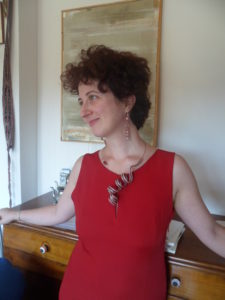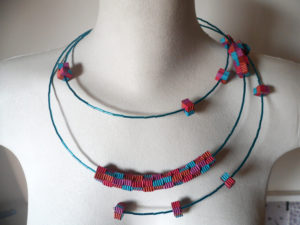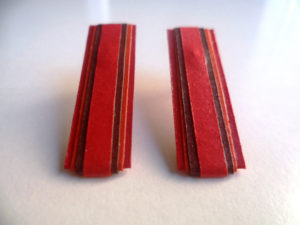Marta Proietti Gaffi is an Italian artist who creates craft works of art in paper. As an artisan who is always very attentive to social issues and curious of the world and its experiences, Marta builds bridges between people in the name of beauty trying to draw inspiration from the reality around her. She does so with with paper, which is her ideal material: it is “versatile, generous, common, varied, easy-to-handle and gratifying” and enables her to create pieces of micro-architecture, i.e. jewels.
With a degree in architecture from IUAV, Venice, Italy, Marta Proietti Gaffi reproposes architecture in her creative projects. With paper. Yes, because «paper is at the basis of architecture, and it was even more so before the age of computers». And she adds that «this splendid and multifaceted material has always been there next to me, yet I used to see it as a means and not as an end. All of a sudden, it asserted itself in its entire material nature and, as I remembered a jewel design course I had attended in Vicenza, I set out to manipulate paper to create micro-architectural creations like jewels».
This is how Marta describes her approach to paper, in the key of sustainability: «Also following a master course on the management and energy resources and environmental sustainability, that I attended in Rome, since the very beginning I have worked with waste papers, because I felt freer to experiment and the mistakes I would have made, if one can talk of mistakes, would not have been important. Knowing you can work with waste material that is bound to be recycled has given me the necessary freedom to experiment».
Enough freedom to suggest some kind of art therapy of the creative process: «As long as I created small objects, cut stripes of paper, bent cardboard and assembled the whole, I would realize that I was feeling good. The creative process from the initial sketch of an idea to the final object would give sense to my thoughts and express my being. I would gradually start seeing things from a different angle and realize that I was rediscovering that architecture, which had gone lost, i.e. architecture with a capital A, exactly as is supposed to be. And as a matter of fact, I feel more an architect now than I used to feel before. This way paper has taken me a long way, leading me to the generation of Zero Più Marta“.
Let’s discover from Marta’s words where her journey with paper has taken her in this interview with Paper Industry World.
MORE THAN JUST PAPER
Zero Più Marta is a world, that Marta shares with her husband Marco, made of paper, satisfaction and close personal relations. It is a peculiar name, that Marta describes as follows: «Zero is the value that is generally attached to waste objects and materials. Zero Più, i.e. Zero Plus, is my way of seeing this waste, which turn into resources to me, that are rich in potential for a new future. Finally, my name Marta added to the combination expresses the need to express uniqueness, to counter a world of labour that shamelessly brags about the interchangeability between people. Taking back one’s own identity and the right to express ourselves is thus a fundamental step for professional and social fulfilment».
When was Zero Più Marta first conceived?
«Giving birth to Zero Più Marta took me a long time, about ten years, because this name was the result from a specific mood, i.e. the way of feeling it originated from. Zero Più Marta first originated in January 2011, when I realized that the time had come to try and build something for me and using my own forces. At the beginning all my creations obviously lacked experience, but they were beautiful and I had made them. This gave me the confidence to attempt proposing them to the outside world, to make myself seen through the objects that I had created. This second step, which is very important and probably more difficult than the first one, is paramount. The relation with the public can give you confidence, but also make you feel bad if you are not used to propose yourself and the objects that you make with your own hands. But I have been very receptive and I carefully listened to the advice given by more experts artisan colleagues, and I deeply enjoyed the praises and encouragements for my work by people. The relation with the others, who are ultimately your direct or indirect customers, has helped me make the necessary adjustments, understand what I liked and what they liked, and eventually find a way or a niche that turned out to be the winning one. I have many more certainties now, however without the experiences and experiments made I would have never reached the stage where I am now. But everything changes and keeps on transforming, and I also changed together with the paper I work and recover. At the beginning there was total experimentation, from paper and cardboard handbound notebooks, greeting cards, paintings and art compositions to home furnishings. Later, I added lamps and jewels to the list».
Who were your masters?
«Theory is fundamental, and equally fundamental are the books I read and the research activity I carried out in libraries and on-line. Practice teaches what theory frames and sketches. I strongly believe in the quote by Bruno Munari, who used to say that «If you listen, you will forget; if you see, you will remember; if you do, you will learn». Noone is born knowing everything. Curiosity is the engine that drives knowledge. Studying provides contents and matter, and stirs curiosity. Constant practice and exercise improve manual skills and make ideas possible by generating new ones. The masters I have now and I had in the past are all the people I meet, who enrich my curiosity and my skills. Artisans who are colleagues of mine and boast more experience are fundamental to understand various professional and growth profiles. The same applies to novice colleagues, who are more technological and willing to experiment and help me dare more and make those leaps forward that are fundamental to bring things up a notch in quality. Proceeding in small steps helps consolidate one’s own competences, to then test yourself in more important settings to raise the bar of your activity. People, customer, buyers, friends and the public are all mirrors reflecting lessons and helping mature and grow. No man is an island and no beauty can be an end in itself. I believe one should generate beauty and that this beauty should be shared with as many people as possible, thereby meeting the tastes and fulfilling the needs of most of them. If something cannot be shared, then it loses most of its value».
Let’s talk about your jewels: how do you create them, where do you draw the inspiration from?
«Jewels are born in many different ways, from instinct and the type of paper I have in my hands. Every year I set out to learn at least a working technique: I started with papier-mâché, then I was fascinated by quilling, then by carving, etc. I apply every technique to a specific type of paper, because the first objective is to increase the value of each individual piece of paper. For example, I turn newspaper into a paper thread that can even be knitted; magazine paper, instead, becomes suggestive through the folds of origami. A sharp and deep spirit of observation and listening are needed. I’m very observant of the surrounding world, both human and natural, fashion and art history, then I create the jewels I would like to wear: the jewels that accompany mood changes and enhance them; the jewels that make you smile again when you are sad thanks to a rainbow; the jewels you can consume from wearing them when you are nervous, and they are there exactly for you. Light jewels that enhance the beauty of any woman wearing them.
The question I have to answer most frequently is the following: “what happens if it rains?”. This is a legitimate question, although I hope nobody else will ask this question in the future, because the true nature of my jewels will have been understood. I process all my costume jewellery, with water-based paints, so as to create a protective layer that makes them resistant and resistant to occasional drops of water, moisture and sweat. The secret lies in paying little attention, that is why it’s enough not to have a shower wearing them or soak them».
And what about lamps, instead?
«The lamps you create are produced with the technique of carving and/or quilling. I generally create them on commission and, therefore, I draw inspiration from the requests addressed to me. Sometimes, instead, I carve what I like, like owls, horses, herons, hearts, flowers, fish; or I combine spirals of colours that fascinate me or that I like to see next to one another. The interesting thing of my lamps is always the play of light they emit, for some lamps the possibility to adjust this light emission by lifting or lowering the mobile elements originated by the carving, like, for example, the owls’ feathers, the fish fins or hearts’ wings. The lamps are then treated to prevent dust from depositing and damaging them. Thanks to the application of a natural paint, the lamps are easy to dust and can be touched without problems. And nowadays we have LED light sources, which do not warm up, and the entire electrical part is EC certified».
What kind of paper do you prefer?
«Zero Più Marta uses a number of cardboards of various paper weight, colour (including white or ivory, which is used as is or painted with indelible colours) and quality: smooth, rough, parchment, linen-blend paper, tissue paper, etc. Furthermore, Zero Più Marta makes use of the coated paper of weekly magazines, which provides for a highly urban and fashionable effect; as well as the paper of daily newspapers, which is worked with the spindle, like wool, to create a twisted thread that can be modelled and applied in various ways. The papers used for the brochure or advertising leaflets create an ethnic and surprising effect, as you would never say that paper is the the original material. Furthermore, the real cardboard is ideal to create jewels and furnishing items. The last paper added to the list of the ones used is the paper of books destined for pulping, which are carved and assembled with one another in various forms, to create a whole set of new creations».
What kind of techniques do you use?
«Quilling is the most popular and widely used technique. It consists in rolling paper strips to create spirals, which can then be modelled in several shapes and become oval, blades of grass, sunrays, hearts, etc. If you cut the paper in triangular forms, instead, a whole world opens up made up of paper beads of various length, thickness and sizes. Other techniques that are commonly used include the so-called scooby-doo, which consists in a geometrical braid of four strips that, in this case, too, are of different shapes: rectangle, rhombus, triangle. This technique is an origami in the classic sense of that term, i.e. «paper fold». Paper carving never fails to appear, both as a preparation of other techniques, and as a stand-alone element. Carving is done by hand with cutters or scalpels, and it is precise and elegant. Finally, the paper thread made with the spindle using strips of newspaper, is an elegant and lightweight alternative to fabric threads in general and looks extremely contemporary in its material aspect».
These are all reasons why you chose paper, and there is many of them…
«Is Zero Più Marta a gift made by paper or is paper now enriched with Zero Più Marta, instead? Maybe it’s both. I did not initially plan to focus only on paper or to choose this wonderful material as the only material for my creations. Back then, exactly like now, I was curious about other materials and I liked experimenting with them: fabrics, metals or wood. But paper has really fascinated me. First, because it has a history that is nearly 3,000 years old. Paper has always been with us, it has always transformed and been able to astonish us again, and what I do is evidence of this. Paper is a living material, with its fibres, peculiarities, folding points and the points where it is more resistant: it almost indicates that way it should be handled and worked; certain papers lean themselves better for a given purpose, other papers for other uses. Paper is democratic: very few materials are so widespread and easy to find. In small quantities it is even lightweight and it takes little to work it: a cutting board, a cutter, some glue to start with. If you want to start from scratch and have little room available, there is no better material than paper to start with. Paper enables you to work in big scales, as well as to create very small objects. Paper has taken over, as I can manipulate it very quickly and using different techniques that enable me to fulfil my creative needs pushing me to see the prototype made almost in real-time. Paper is, furthermore, a fascinating, precious, fragile and resistant material at the same time, depending on how you use it. It comes in a large number of qualities, makes, textures and colours. Working with paper is a truly emotional experience. In short, it is versatile, generous, popular, varied, easy to handle and gratifying. It is my ideal material».
What is your reference target?
«I make lamps, various kinds of furnishing items, greeting cards and items for ceremonies, i.e. Invitations and candy boxes, but jewels and accessories are definitely my highlights. Even if I make only a limited number of men’s accessories, like cufflinks or some types of bracelets, most of my jewels are designed for women. So, women of all ages are my direct addressees: direct if they purchase my jewels themselves, or indirect if they receive them as a gift. Having said this, my customers include all those who appreciate my work, whom I meet, who happen to see my creations and are fascinated by them. I don’t think before about specific groups of people who might like my work more than others, even if experience has taught me what type of jewels are better suited for a person rather than to another. I do not intend to limit my creative activity to a niche audience. I rather prefer to meet the others, showing my true self in explaining, telling and describing my activity. Of course, I also work on commission and this is stimulating. Some of my creations have been designed to meet specific requests and have later on become real collections. Requests are fundamental as a moment of exchange and a creative push to do something new. Furthermore, it is really beautiful to work with clients who rely on you, be they near or far; and when I succeed in astonishing and impressing them, the sense of achievement is enormous».



